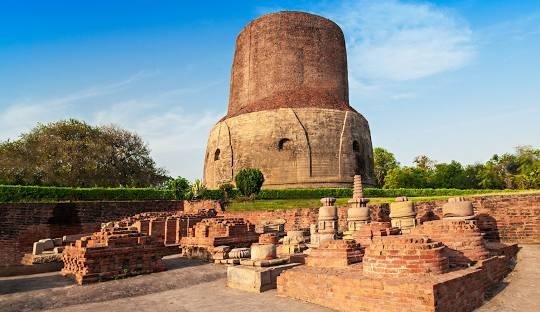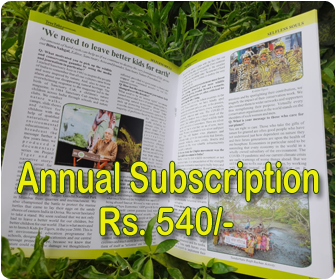Travelogue
HN Singh
The writer is a Lions International Faculty Member, SPHEEHA, Naturalist, HAM Radio Licensee, trekker & mountaineer
The Buddhist Circuit is more than a trail of monuments and ruins—it is a pilgrimage through time, culture, and the deepest questions of existence. My own journey began in Shravasti, wound its way to Lumbini in Nepal, passed through Kushinagar, and concluded in Sarnath. Each place carried a distinct echo of the Buddha’s life: teaching, birth, liberation, and the first turning of the Dharma wheel.
Shravasti – the city of miracles and teachings
Nestled near the Rapti River, not far from the Nepalese border, Shravasti was once the thriving capital of the Kosala kingdom. Today, it is best known as the city where the Buddha spent 24 monsoon retreats—his longest sojourn anywhere.
The centerpiece of Shravasti is the Jetavana Monastery, built on land donated by the wealthy merchant Anathapindika. As I walked among its ruins, I could almost hear the murmur of monks gathering for discourses, the rhythm of chants echoing through the air. The Gandhakuti, believed to be the Buddha’s own hut, and the Ananda Bodhi Tree, planted by his devoted disciple Ananda, remain powerful focal points for pilgrims.
Shravasti is also a city of stories. It was here that the Buddha performed some of his most famous miracles: multiplying his form into countless manifestations, or calming a furious elephant with nothing but presence and compassion. These accounts may belong to legend, but standing in the silence of the Jetavana, one feels the possibility of the extraordinary.
The city was once a vibrant hub of trade, culture, and spirituality. Later, it declined, its glory buried until rediscovered by archaeologists in the 19th century. Today, Shravasti has returned as a place of pilgrimage, where monasteries built by Thailand, Korea, Tibet, Sri Lanka, and Myanmar stand as modern symbols of a timeless faith.
Leaving Shravasti, I felt I was not departing from ruins, but from a living space of wisdom—one that carried the essence of continuity between past and present.
Lumbini – the sacred birthplace
From Shravasti, the road leads northward across the Indo-Nepal border to Lumbini, where the Buddha’s journey began. Unlike Shravasti’s broad ruins, Lumbini radiates a sense of sacred origin. This is the ground where Queen Maya Devi gave birth to Siddhartha Gautama in 563 BCE, under the shade of a Sal tree.
The Maya Devi Temple is the heart of Lumbini. Inside, a marker stone and bas-reliefs commemorate the nativity. Outside, the sacred pond and the Ashokan Pillar, inscribed in the 3rd century BCE, proclaim the site’s authenticity. Pilgrims walk in quiet devotion, their prayers merging into a collective murmur that transcends language.
Around the temple complex spreads the monastic zone, where different Buddhist nations have built monasteries reflecting their unique traditions—Thai gilded roofs, Japanese pagodas, Sri Lankan stupas, and Tibetan murals. Each structure adds to Lumbini’s global character, a reminder that from this small town, a philosophy of compassion and mindfulness spread across continents.
Sitting in the gardens, I thought of the paradox: a prince born here would one day abandon all comfort in search of truth. Lumbini is not just a birthplace; it is a symbol of beginnings, of the human potential for transformation.
Kushinagar – the final mahaparinirvana
Traveling south from Lumbini brought me to Kushinagar, where the Buddha attained Mahaparinirvana, leaving behind the cycle of birth and death. The atmosphere here was markedly different from Lumbini’s energy of beginnings. Kushinagar is about completion, quietude, and ultimate peace.
The Mahaparinirvana Temple houses the serene, 6.1-meter-long reclining Buddha statue, carved from sandstone. The Buddha’s face, even in death, is touched by a smile that seems to radiate eternal calm. Pilgrims sat in silence around the statue, some weeping softly, others immersed in meditation.
Nearby stands the Rambhar Stupa, believed to mark the site of the Buddha’s cremation. Its simplicity contrasts with its emotional weight. Standing there, I imagined the grief of the disciples, yet also their resolve to carry the teachings forward.
Kushinagar is also a meeting ground of global devotion. Monasteries built by Japan, Thailand, Sri Lanka, and Myanmar dot the town, each showcasing their national architectural styles. Yet, within their diversity, they share the same reverence. Walking through them, I felt how the Buddha’s teachings transcended borders, becoming a universal language of peace.
Kushinagar does not feel like an end. It feels like a promise—that liberation, the cessation of suffering, is possible. Leaving the town, I carried with me not sorrow, but a sense of fulfillment.
Sarnath – where the wheel of dharma turned
The last destination of my journey was Sarnath, just outside Varanasi. If Lumbini was about beginnings of life and Kushinagar about endings, Sarnath represented the turning of the wheel—the sharing of enlightenment.
It was in Sarnath’s Deer Park that the Buddha, after attaining enlightenment in Bodh Gaya, delivered his first sermon to his five companions. In that moment, the Four Noble Truths and the Eightfold Path entered the world, charting a course that would guide millions.
The Dhamek Stupa, an imposing cylindrical structure, marks this spot. Pilgrims circumambulate it with folded hands, their chants blending with the rustle of leaves. The stupa stands not just as a monument, but as a living reminder of the day when silence broke into wisdom.
Scattered around are ruins of monasteries, prayer halls, and remnants of the Ashokan Pillar, whose lion capital now adorns India’s national emblem. The Sarnath Museum preserves this lion capital along with exquisite Gupta-era Buddha images. Each sculpture radiates serenity—the kind of peace that seems to echo directly from the Buddha’s teachings.
Sitting under the Bodhi tree in the park, I felt an inner stillness. The air seemed charged with memory—the memory of that first sermon, when the Buddha spoke not as a seeker but as a teacher.
Reflections on the circuit
My journey across Shravasti, Lumbini, Kushinagar, and Sarnath felt like tracing the arc of human experience itself. Shravasti spoke of living the years of teaching, miracles, and community. Lumbini whispered of beginnings-the miracle of birth, the promise of transformation. Kushinagar reminded me of endings-not in despair, but in the serenity of liberation. Sarnath proclaimed that the sharing of the Dharma had become universal. Together, these places form not just a travel route but a spiritual map: life, birth, death, and truth interwoven.
Travel, I realised, is not merely movement across land. It is a dialogue with time, history, and one’s inner self. Walking in the footsteps of the Buddha, I carried back more than photographs and memories. I carried back stillness, an invitation to live mindfully, and a reminder that the Buddha’s path is not bound by geography or time. It is available to anyone who seeks peace.
















Leave a comment